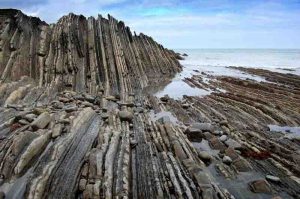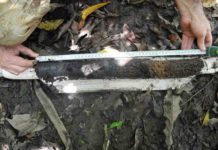
Flysch is a sequence of sedimentary rocks that is deposited in a deep marine facies in the foreland basin of a developing orogen. Flysch is typically deposited during an early stage of the orogenesis. When the orogen evolves, the foreland basin becomes shallower and molasse is deposited on top of the flysch. It is therefore called a syn-orogenic sediment (deposited contemporaneously with mountain building).
The name flysch was introduced in geologic literature by the Swiss geologist Bernhard Studer in 1827. Studer used the term for the typical alternations of sandstone and shale in the foreland of the Alps. The name comes from the German word fliessen, which means to flow, because Studer thought flysch was deposited by rivers. The insight that flysch is actually a deep marine sediment typical for a particular plate tectonic setting came only much later.
Sedimentological properties
Flysch consists of repeated sedimentary cycles with upwards fining of the sediments. At the bottom of each cycle are sometimes coarse conglomerates or breccias, which gradually evolve upwards into sandstone and shale/mudstone. Flysch typically consists of a sequence of shales rhythmically interbedded with thin, hard, graywacke-like sandstones. Typically the shales do not contain many fossils, the coarser sandstones often have fractions of micas and glauconite.
Flysch is formed under deep marine circumstances, in a quiet and low-energetic depositional environment. The coarser layers (which require higher energy) are disruptions in these circumstances, caused by pulsewise flows of mass transport from the forming orogenic wedge. In many cases the mass transports are represented in the record by turbidites.
Tectonics
Flysch deposits form at convergent plate boundaries at the stage of continental collision, often in remnant ocean basins that are present along the same boundary. The sedimentary material in the flysch is derived from the forming mountains and deposited along the axis of the new mountain chain into remnant ocean basin. The same ocean basin is in the process of subducting under the orogenic wedge. As subduction continues, the flysch sediments are scraped off the down-going oceanic plate and are accreted onto the orogenic wedge. As a result, flysch deposits are often highly deformed by thrust faulting and folding.










